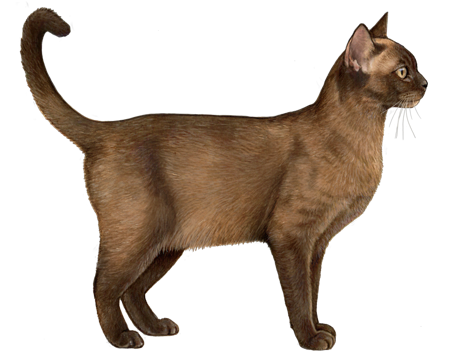
Kurilian Bobtail
Kurilian Bobtails are highly intelligent, easily trained cats that adapt well to all environments. Their outgoing personalities and peaceful nature make them an excellent fit for just about any family.
Interested in discovering if your cat is a Kurilian Bobtail?
Check out Wisdom Panel's DNA test.
Kurilian Bobtail Traits
General Appearance
Kurilian Bobtails are medium-to-large cats with pompom tails and a wild appearance. They have compact bodies and broad chests that give an overall impression of strength and power.
Coat and Colouring
Long- and short-coated varieties of the Kurilian exist. Both have a moderate undercoat and silky texture, but longhairs also have a ruff, britches, toe tufts, and plumed tails. This breed comes in various colors and patterns—including bi-color, patched, tortie, solid, smoke, silver, and golden.
Distinctive Physical Traits
When it comes to this breed, no two tails are alike. Each consists of a series of kinks or curves that create a whisk, spiral, or snag shape. Other notable features of the Kurilian include a large, modified wedge-shaped head, walnut-shaped eyes, and medium, triangular ears.
Kurilian Bobtail Temperament
Kurilian Bobtails have a "go with the flow" attitude that makes them well-suited for life with other pets and kids. They're trusting, outgoing cats with very balanced personalities. Under the bed sheets or on a lap are their favorite places to sleep.
Life with a Kurilian is typically a low-key affair. These cats have a clownish nature and enjoy playing, but they're only a moderately active breed. Kurilian Bobtails are intelligent, quickly learning house rules and commands. And when they want to get a better view of the world, they use their impressive jumping skills to launch themselves onto high lookout points.
Kurilian Bobtail History
The Kurilian Bobtail traces its origin to the Russian Island of Sakhalin and the Kuril Islands that separate the Sea of Okhotsk from the Pacific Ocean. According to documentation, short-tailed cats have lived on the islands for over 200 years. Experts believe either military members or scientists brought the cats to central Russia in the mid-20th century.
When Kurilian Bobtails first appeared in cat shows in 1990, experts speculated that the cats were versions of the Japanese Bobtail. And it's likely the Kurilian was the source of the original gene mutation that causes the Japanese Bobtail's short tail. (This has yet to be proven.) One key difference, however, is that the Japanese Bobtail was carefully bred into existence, whereas the Kurilian came about naturally.
Kurilian Bobtails have keen mousing skills—a talent that made them popular pets in Russia. But it's their laid-back attitude that earned the favor of many families throughout Europe.
Despite their compelling qualities, Kurilian Bobtails have yet to make a name for themselves in North America. Fewer than 100 cats of this rare breed live in the United States today.
Kurilian Bobtail Care
Nutrition
Kurilian Bobtails require a high-quality diet formulated for their current age group (e.g., kitten, adult, senior).
To keep your cat at a healthy weight, measure out meals and reduce portions if necessary. And don't forget to account for treats. As a guideline, they should make up no more than 10% of a cat's calories.
Finally, all cats need access to fresh, clean water around the clock.
Grooming
The Kurilian Bobtail's coat isn't prone to mats or tangles. Both longhaired and shorthaired varieties have relatively low-maintenance grooming needs. Brushing once a week will remove loose fur and keep your cat looking their best.
Most cats' nails require monthly trimming to prevent them from getting too long. Long nails are more likely to snag on something and become torn or damaged. They can even grow into your cat's paw pads, leading to pain or infection. In addition to clipping, providing a scratching post will allow your cat to do some nail maintenance themselves (thanks to their instinct to scratch).
No grooming routine is complete without a little dental hygiene. To support your Kurilian's overall health, brush their teeth daily and schedule visits with your veterinarian for professional dental cleanings and exams.
Health
Roughly one out of every three cats in the United States is overweight or obese. And those extra pounds can contribute to other health risks—such as arthritis, diabetes, and heart problems. Your veterinarian is the best resource for tips on managing your cat's weight.
Breed Group
Asian
The Asian Group is comprised mainly of genetically similar breeds which vary widely in traits and personalities. These breeds are distinct from those of the Siamese and Oriental Group.
Resources
http://www.acfacat.com/kurilian_bobtail_synopsis.htm
http://www.kurilianbobtails.net/morehistory.html
https://tica.org/breeds/browse-all-breeds?view=article&id=848:kurilian-bobtail-breed&catid=79
https://tica.org/phocadownload/kb.pdf
https://www.royalcanin.com/us/cats/breeds/breed-library/kurilian-bobtail
Reviewed 23 February 2021 by Annette Louviere, DVM























